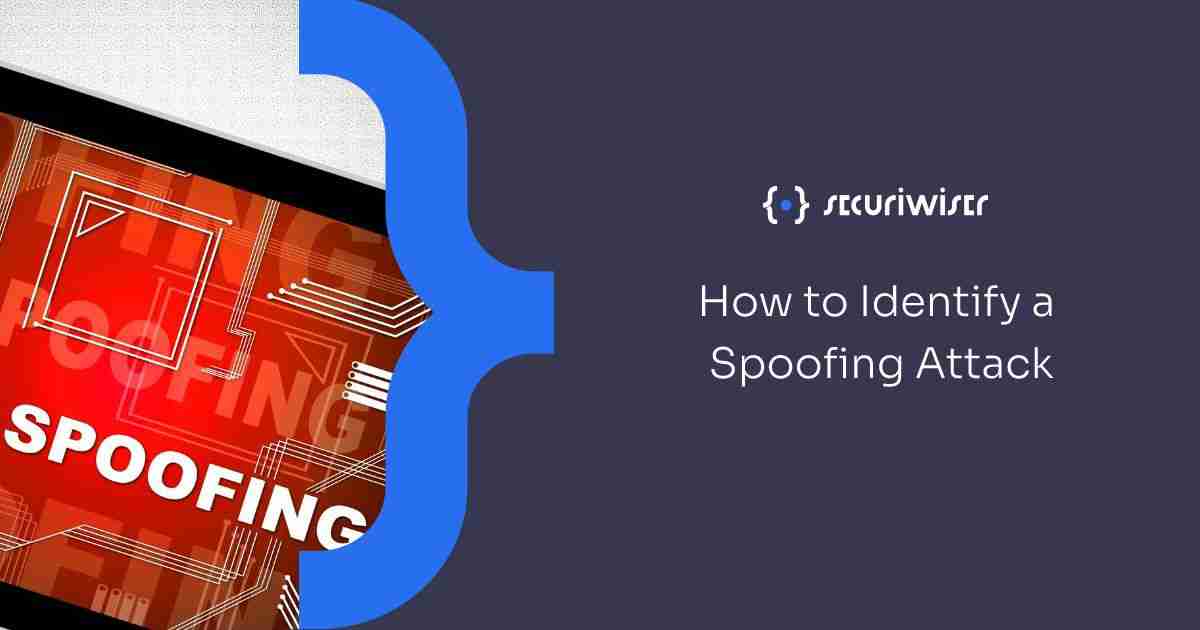How to Identify a Spoofing Attack?
Blog / How to Identify a Spoofing Attack?
4 MIN READ


When you visit a website or open an email, you are putting trust in the person behind it. By opening a website, you trust that the website is legitimate and secure. In cybersecurity, spoofing is the act of pretending to be legitimate by impersonating someone else. Hackers use this trick to manipulate people’s trust to their advantage.
Hackers use this trust to trick victims into clicking malicious links or to send them money or data. For example, they may send an email to a victim pretending to be Apple. They may ask the victim to validate their account details by clicking a link in the email. This will then send the victim to a fake website designed to look like Apple’s official website. When the user enters their information, their account gets stolen.
Types of Spoofing Attack
Spoofing attacks come in many shapes and sizes. Often, hackers will pretend to be trusted businesses. Other times, they may pretend to be a colleague or boss, sending fake emails to employees. Being able to identify a spoofing attack will help you secure yourself and your business against many kinds of cyberattacks.
Email Spoofing
Spoofing an email is extremely common, and is a regular tactic used by hackers in phishing attacks. Email spoofing comes in many varieties, ranging in complexity depending on the target. In basic phishing attacks, hackers will pretend to be trusted companies to try to get victims to download some kind of malware.
Email spoofing can get far trickier than that, however. Businesses should be wary of spear-phishing attacks. In these cases, malicious actors will pretend to be an executive, or maybe a third-party associate company. It is usually difficult to detect these kinds of spoofed emails, and they target specific employees with access to company assets, data, or funds.
Business Email Compromise
While technically still part of email spoofing, business email compromise deserves a separate mention. This type of spoofing is where hackers disguise themselves as a member of a business. This is done either through a slightly misspelt email address or a company email address the hacker has managed to get access to. These types of emails often aren’t picked up by spam filters, so they can be quite dangerous.
Website Spoofing
Spoofed websites are often a follow up to phishing attacks. Fake websites likely won’t appear on a search engine, so hackers use social engineering tricks to get victims to visit the sites. Like in the Apple example given earlier, hackers send these links in phishing emails. The websites will often look legitimate at first glance.
These fake sites will trick victims into downloading malware or inputting their details.
Man-in-the-Middle Attacks (MitM)
MitM attacks are when a hacker intercepts communications on a Wi-Fi network. This type of attack usually happens on unsecured public networks; however, it can also be spoofed. Hackers will set up a fake Wi-Fi network that looks almost identical to the normal one. When a victim connects to it, all the data their device transmits on the network will be intercepted by the hacker.
DNS Spoofing
The DNS translates web addresses into IP addresses so a web browser knows where to direct the user (more on DNS and DNS attacks). DNS spoofing is when a hacker changes the IP address that the DNS translates to. When a victim clicks on a spoofed website, the DNS will redirect them to a website made by the hacker, instead of the website they wanted to go to.
Caller ID Spoofing
Caller ID is used by mobile phones to identify callers. Scammers can spoof their caller ID by using fake information on Voice Over Internet Protocol (VOIP) services such as Skype. These VOIPs allow scammers to create a phone number and identity for themselves. The victims of caller ID spoofing will then be tricked by the scammer on the other end to send them money or information.
Identifying Spoofing Attacks
There are often tell-tale signs that a website or email is spoofed. Knowing what to look out for will help you better identify these fakes.
Basic spoofed emails are often littered with spelling mistakes. They are also likely from an incorrect email address. Always check the address to look for subtle differences. If you are a link to a website in the email, that will also likely be incorrect. In case you have to click on a link, double-check to make sure it is to the official website. Scam messages will often feel urgent, trying to shock you into taking action fast.
Spoofed sites will often look slightly different than the official ones. They may look more amateur or hastily made. You can also verify this by looking in the address bar at the top of your browser. Scam sites are generally not secure and will not be hosted on HTTPS. If the web address starts with http:// instead of https://, there is a good chance the website is not legitimate.
Preventing Spoofing Attacks
Spoofing attacks can be prevented in several ways. Here are some examples:
- Avoid links and attachments. Spoofed emails will often trick victims into downloading malware or giving up passwords. If you receive an unsolicited email, don’t trust any links or attachments until they can be verified.
- Confirm any actions with your company. Spoofed calls and spear-phishing attacks often prey on employees of a business. Sometimes, scammers will forge invoices, or ask you to transfer data to them. By verifying the claim with the sender, you will avoid playing into the scammer’s hand.
- Use an email spam filter. Spam filters do a good job of removing most spoofed emails from your inbox. Spam filters prevent spoofing attacks by removing spoofed emails from the picture.
- Use an antivirus. Spoofing attacks often ask victims to download some form of malicious software or attachment. Antivirus software will prevent you from downloading most malware and will be able to clean up your computer in case any malware is downloaded.
Securiwiser Can Help Protect Your Business
Securiwiser can help you lower the risk of a spoofing attack happening to your business. We offer real-time cybersecurity monitoring to help you find weaknesses in your cyber defences. Our monitoring suite evaluates your network in many different areas. One such area is email security, allowing you to shore up your defences against email risks such as business email compromise.
On top of monitoring your network, Securiwiser offers in-depth, beginner-friendly advice so you can stay in the know. Our goal is to provide you with the information you need to improve your cybersecurity posture at a price affordable on all budgets.
Click here for a free cybersecurity evaluation, and find out how you can improve your cybersecurity posture with Securiwiser.
Previous Article
How Will Quantum Computing Change Cyber Security?Next Article
What is Malvertising? Preventing Advert MalwareHow secure is
your business?
Blog categories
How secure is
your business?